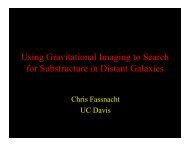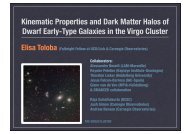DPS 42nd Meeting Abs..
DPS 42nd Meeting Abs..
DPS 42nd Meeting Abs..
- No tags were found...
Create successful ePaper yourself
Turn your PDF publications into a flip-book with our unique Google optimized e-Paper software.
<strong>Abs</strong>tract: Cloaked in light from Saturn and its rings, the medium-sized Saturnian satellite Mimas is difficult to observe form Earth, and it was the only majorsatellite not to have a close encounter by the Cassini spacecra. Observaons of the moon during Ring Plane Crossing in 1995 and by the Hubble SpaceTelescope established that the moon has a visual geometric albedo of greater than unity (Verbiscer et al. 2007, Science 315, 815) and a brighter trailing side(Bura et al. 1998, Icarus 136, 223), suggesng it is being coated by the E-ring. Observaons at opposion obtained by the Cassini Visual Infrared MappingSpectrometer (VIMS) instrument between 0.4 and 5.2 microns show the moon has a surge similar to that seen on other icy bodies, increasing in brightness by over30% in the last five degrees. During the closest nontargeted flyby by Cassini on February 13, 2010, when the Cassini spacecra approached within 9500 km ofMimas, maps of the moon were obtained by VIMS. Water ice absorpon bands in the central peak and crater rim of Herschel are deeper than those in thesurrounding regions. Preliminary results indicate the water ice grain size decreases as the distance from the apex of moon increases. No constuents other thanwater ice have yet been idenfied.Funded by NASA.01.09: Mimas: Preliminary Evidence For Amorphous Water Ice From VIMSAuthor Block: Dale P. Cruikshank 1 , G. A. Marzo 2 , N. Pinilla-Alonso 1 , T. L. Roush 1 , R. M. Mastrapa 1 , C. M. Dalle Ore 1 , B. J. Bura 3 , K. Stephan 4 , VIMS Team1 NASA Ames Research Center, 2 Bay Area Environmental Research Instute, 3 Jet Propulsion Lab., 4 DLR - German Aerospace Center, Germany.Presentaon Time: 10/4/2010 9:50 AM - 10:00 AMLocaon: Ballroom BC<strong>Abs</strong>tract: We have conducted a stascal clustering analysis (1,2) on a mosaic of VIMS data cubes obtained on February 13, 2010, for Saturn’s satellite Mimas.Seven VIMS cubes were geometrically projected and re-sampled to a common spaal resoluon. The clustering technique consists of a paroning algorithmcoupled to a criterion that prevents sub-opmal soluons and tests for the influence of random noise in the measurements. The clustering technique is agnoscabout the meaning of the clusters, and scienfic interpretaon requires their a posteriori evaluaon. The preliminary results yielded five clusters, demonstrangthat spectral variability across Mimas’ surface is stascally significant. The raos of the means calculated for each of the clusters show structure within the 1.6-µm water ice band, as well as the shape and the central wavelength of the strong ice band at 2 µm that map spaally in paerns apparently related to thetopography of Mimas, in parcular certain regions in and around Herschel crater. The mean spectra of the five clusters, show similaries with laboratory spectraof amorphous and crystalline H 2 O ice (3) that are suggesve of the presence of an amorphous ice component in certain regions of Mimas, notably on the centralpeak of Herschel, on the crater floor, and in faults surrounding the crater. This may represent a mixture of both ice phases, or perhaps a layer of amorphous ice ona base of crystalline ice. Another possible occurrence of amorphous ice appears southwest of Herschel, close to the south pole.1. Marzo, G. A. et al. J. Geophys. Res. 111, E03002, 20062. Marzo, G. A. et al. J. Geophys. Res. 113, E12009, 20083. Mastrapa, R. M., et al. Astrophys. J. 701, 1347-1356, 2009





